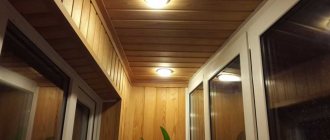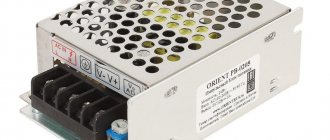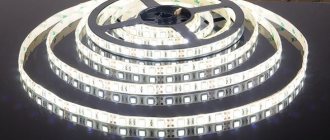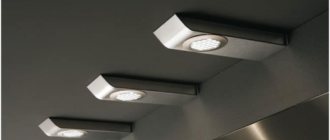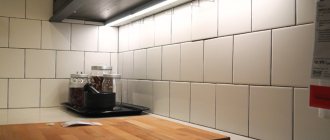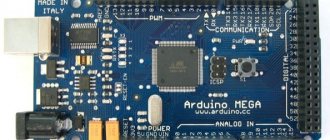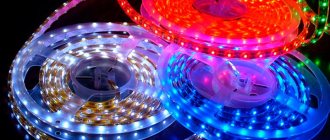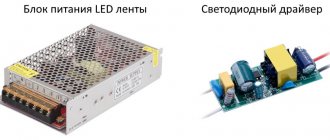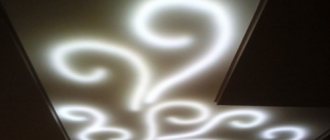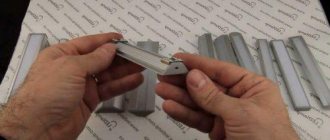LED strip is often used to illuminate various surfaces. Thanks to it, it is possible to create a special atmosphere in the room and an optimal level of illumination. To effectively and comfortably control such systems, a touch switch for the LED strip is used, which has wide functionality. Unlike push-button models, such devices are more convenient to operate. However, before making a choice in their favor, it is worth familiarizing yourself with their distinctive features.
Design features
Any model consists of:
- Front panel. For ease of use, it is often equipped with backlighting. May have different shapes and designs. When choosing a suitable model, many people pay attention to it without delving into the operating principle and functionality of the device as a whole;
- A touch sensor that sends control signals to the device when an external influence occurs;
- A switching circuit, with the help of which an external signal is converted into the electric current necessary to ensure the operation of the tape;
- A body that combines all of the above elements into a single whole. The design of the housing may vary. It can be built-in or overhead. Its type has a direct impact on the order of installation work.
Attention! The service life of a particular device directly depends on the quality of its components.
Where are they in demand?
The need to connect an LED lamp or strip may arise in various situations. Most often, these lighting devices are used if necessary:
- Ensure sufficient lighting of the work area in the kitchen;
- Connect several lighting fixtures at once;
- Organize lighting of staircases and landings;
- Connect the smart home system.
The location of the LED strip in the kitchen is chosen taking into account the goals being pursued. If you need to organize LED lighting for the work area, choose a powerful light source, which is located directly under the cabinets. This option is the most popular, as it helps prevent negative effects on the eyes due to insufficient light levels and makes it easier to care for the countertop.
Integrated lighting is selected for the space around the hood or for furniture. The LED strip is mounted above the upper cabinets or placed under the lower ones. Sometimes they are fixed under the tabletop.
Advantages
The touch light switch has a lot of advantages.
- Easy to turn on and off the device by pressing the sensitive surface;
- Possibility of adjusting the brightness of lighting in a fairly wide range: 10–100%;
- No sound discomfort. When changing the operating mode or adjustment, the device makes virtually no sounds;
- High degree of protection. The switch is not susceptible to moisture. It can be safely installed not only in the kitchen, but also in the bathroom or toilet;
- Presentability. Modern models can become part of any interior, blending harmoniously into the surrounding space;
- Compactness. The devices are characterized by small sizes. This allows you to install the switch anywhere, including in confined spaces. Most often, the switch is mounted in the profile of the LED strip;
- Availability of light indication, allowing you to find devices in conditions of limited visibility.
Miniature motion sensor
There are also motion sensors of this type. That is, not those healthy boxes that hang on the walls or ceiling, but the miniature switches themselves, assembled on a narrow board.
They are also integrated into the profile or directly into the furniture. Their main difference is the range. Here we are no longer talking about a few centimeters, but about a distance of 2-3 meters.
Such sensors can be connected to organize lighting on the ceiling or floor in the corridor. They are very convenient to insert into baseboards.
If you have such a motion sensor, just enter the room and the light will turn on automatically. When idle for about 30 seconds, the light goes out.
The coverage angle of the device is approximately 100 degrees. Based on this, it calculates its positioning.
The motion-sensing element must also be removed from the housing. Drill a hole of the required diameter in the profile or lamp and place the hood outside.
Everything else, along with the threads, remains hidden inside.
Types of switches
Switches offered by manufacturers are divided into various groups depending on:
- Control method. They can be mechanical, electronic or remotely operated;
- Installation method. Some models are mounted directly into the aluminum profile of the lighting fixture, others are model or overhead;
- Connection type. There are pass-through and non-pass-through devices. The main advantage of the first type is the ability to turn on/off the lighting system from different places. The second type can be controlled from one specific location.
All products differ in shape, color and texture of the front panel. This allows you to choose the best option, taking into account the overall stylistic design of the room.
A modern touch switch has a number of additional functions. Such devices may have:
- Remote control with IR sensor. It becomes possible to control the controller and RGB strip. The user chooses the backlight color that he likes best;
- Timer. Functional models that allow you to optimize energy costs. With this function, the user has the ability to configure time intervals when the lighting system operates;
- A non-contact system that responds to changes in ambient temperature, a sharp sound, or is triggered when moving objects are within a given radius;
- Dimmer. A functional element that allows you to change the brightness of the LED strip. Brightness control is carried out within a specified range. Light intensity can be changed in the range from 10% to 100%;
- Capacitive response. This element allows you to increase the sensitivity of the panel.
Attention! Touch switches can be activated when you approach the sensor and after direct contact with your fingers. The latter type is most widespread.
Connection with controller
Multicolor LED strips can be used not only for lighting, but also as an additional decoration for the interior of the room. They are divided into groups and controlled using a remote control and a special controller. Thus, additional elements are added to the circuit.
The color scheme is conveyed in three colors. These are Red, Green and Blue. Therefore, multi-colored LED strips are of the RGB type. Each strip has three groups of LEDs that glow in these three colors. LEDs of the same color do not have schematic connections with each other. Each group has its own output, so any tape is equipped with four contacts, three of which correspond to color groups, and one serves to supply power.
When all three controlled contacts are connected to a common signal output, the color will be white. If you turn them on one at a time, they will only produce red, blue or green. To obtain different shades and control them, the LED strip must be connected through a controller. The controller ensures that all three lines are turned on simultaneously. However, the signal intensity in each channel will be different. Depending on the type of control, these devices can be mechanical or electronic. In the first case, switching is carried out manually, for example, using a conventional three-key switch. The main disadvantage of this method is considered to be a significant limitation in the range of color effects. Electronic controllers provide control of more than just the number of available LEDs. They regulate the intensity of their glow. These devices can be equipped with one or more channels, depending on the number of tapes to be controlled. Each controller has a separate output in the form of a wire with a sensitive element at the end. It is necessary to adjust the light using the control panel.
Which to choose
A large selection of touch switches causes certain difficulties in selecting the optimal option. Such products are boards with average dimensions of 40 × 10 × 2 mm, allowing them to fit into an LED profile, external modules placed in a plastic case, or a controller equipped with a remote control.
We advise you to pay attention to the wireless pass-through switch, which is also convenient to use, especially when lighting long corridors. By turning the light on at the beginning, you can turn it off at the end.
To choose the appropriate option, you must first decide on the type of LED switch. After this, it is worth considering the technical specifications. Noteworthy meaning:
- The voltage that is supplied to the input of the device and created at its output;
- The strength of the current flowing through the device in standby mode and generated when the load is connected;
- Power.
If you decide to install a monochrome LED strip, you should decide on the operating principle of the circuit breaker. Manufacturers offer devices:
- Capacitive, inside of which there is a spring that fits tightly to the plate. When your hand touches the switch, it creates a vibration. As a result, the contact closes and the lighting turns on. However, having decided to opt for such a device, it is worth considering that if the thickness of the plexiglass diffuser is more than 1 mm, you may encounter a lack of operation. This will cause serious inconvenience during operation;
- Infrared, triggered every time there is an object at a distance of 10 cm from the surface, from which the signal is reflected and returns to the receiving element. If the gap between the protective screen and the sensitive element exceeds 5 mm, you will have to use a profile with a shallower depth or take care of the presence of a hole in the light-scattering lens.
If the choice is made in favor of a model with a dimmer, you should also decide on the principle of operation. Such touch switches are most often turned on/off by a short touch. To change the brightness, you need to hold your hand longer on the control panel.
Some models have a slightly different operating principle. They can have several pre-programmed operating modes. Similar devices are suitable for RBG tapes. They are equipped with a control panel equipped with a touch ring. To change the shade of the glow, you need to smoothly move your finger along the spectral circle. As a result, diodes of the selected color or a combination of them will be switched on.
Attention! When choosing a switch, pay attention to the frequency of the PWM pulses. It should be more than 300 Hz so as not to have a negative effect on vision and the nervous system.
Voting for the best touch switch with Aliexpress
Which touch switch would you choose or recommend on Aliexpress?
HIPER TO3W
0.00% ( 0 )
Smart Wifi LCD Touch Switch
0.00% ( 0 )
Delviz smart switch
0.00% ( 0 )
Broadlink TC2S-US
0.00% ( 0 )
Sesoo RF433
0.00% ( 0 )
Minitiger MT-S601-F01W
33.33% ( 1 )
Bingoelec touch switch
0.00% ( 0 )
FROGBRO KG-001
0.00% ( 0 )
ESOOLI 01-01EU
0.00% ( 0 )
MINITIGER MT-Wifi-01
33.33% ( 1 )
LIVOLO C702S
33.33% ( 1 )
AVATTO Tuya TS0
0.00% ( 0 )
SMATRUL H2 (EU)
0.00% ( 0 )
BSEED
0.00% ( 0 )
COSWALL
0.00% ( 0 )
SRAN SR-EUT01SL
0.00% ( 0 )
Installation Features
Connecting a finished device to an LED strip usually does not cause difficulties. However, it should be remembered that LED strips operate on a voltage of 12–24 V. To ensure the required voltage values, the connection to the network is made through a power supply.
When connecting to a finished lamp with an LED strip, the diffuser and plug are removed. On the tape, 1–2 sections are cut to a special mark. The switch will be installed in the vacant space.
To carry out installation work, you will need special connectors of a suitable size or a low-power soldering iron. The power of the latter should not exceed 40 W. Otherwise, there is a risk of damage to the wires when connecting the elements to each other.
Attention! Installation work is carried out using a cable with a cross-sectional area of 1.5 mm². If you are going to install a tape whose length exceeds 5 m, additional calculations should be performed to find the optimal transverse size of the wires.
Now let’s talk about how to connect the switch to the LED strip correctly.
- The wiring strands are stripped and crimped;
- The prepared wiring is connected to the switch connector, which is located in front of the power supply;
- The wires are connected to the lighting element.
In order not to make a mistake when connecting a touch switch, you should pay attention to the markings that are indicated on the product body:
- VCC, GND. The plus and minus are connected here, through which the devices are powered;
- LED+, LED. These contacts are intended for connecting an LED strip.
Attention! Adhesions should be properly insulated.
As insulation, heat-shrinkable tubing of a suitable size or hot-melt adhesive is most often used. The working parts in the selected device must be located on one side. Otherwise, the switch will not be able to be fixed in the profile. A blue LED indicator is used to indicate the location of the sensor.
To fix the switch and LED strip in the aluminum profile, double-sided tape is used. The protective panel is installed last and is secured with a plug.
Touch switches quickly respond to even the slightest touch. This causes certain inconveniences and difficulties during installation work. Considering that the device instantly responds to even a slight touch, you should act with extreme caution and avoid even minor accidental touches to the sensor.
Switch for LED strip in the kitchen
LED lighting for the kitchen: do-it-yourself selection and installation
Modern kitchen equipment makes the cooking process less cumbersome. Proper room lighting and LED lighting for the kitchen under cabinets creates a comfortable environment for the home chef.
Content
Everyone knows about the advantages of LED lighting compared to both traditional incandescent lamps and energy-saving lamps. This is extremely high efficiency and durability. It is also important that the LEDs light up at full power instantly, without requiring time to warm up, and their service life does not depend on the number of on-off switches. The only drawback is the relatively high cost. But the costs are justified: LED lighting in the kitchen will last for several decades, saving a lot of money due to low energy consumption.
If you already have a different type of kitchen lighting, do not rush to change it to a new one. Manufacturers produce LED lamps for almost any type of base and, most likely, you can only replace the lamp itself without changing anything in the lamp or limiting yourself to minor alterations.
Recommended ergonomic kitchen lighting schemes
Proper lighting in the kitchen should be multi-zone. This includes general lighting, light above the dining table and, of course, LED lighting for the kitchen work area.
A sophisticated consumer, technically savvy and familiar with the latest in interior design, often does not limit himself to functional lighting alone.
Where should and can kitchen lighting be located?
- Work area - lighting under cabinets.
The lighting level in the work area should be as high as possible
- The hood above the stove has built-in lighting.
If the hood light seems insufficient to you, standard lamps can be replaced with brighter and more economical diode lamps
Additional lighting in the following places adds convenience or simply decorates the interior:
- Illuminated glass cabinets. If you don't have collectible dishes, put frosted glass in the door, it's no less beautiful.
The soft light emanating from the glazed cabinets visually lightens the kitchen set
- Above the upper cabinets, if the room has sufficient height. Light directed to the ceiling will make the room visually higher
- Under the lower tier of cabinets. The light source should not be visible, so a thin and inconspicuous LED strip for the kitchen is best.
LED lighting directed at the ceiling and floor in the kitchen above and below the cabinets is not intended for work, so it may not be white, but colored. The upper light can be bright, and the lower light should be dimmed, noticeably softer than in the work area
- An LED strip in the kitchen can be installed under the countertop and directed along the fronts of the lower cabinets, highlighting their contents.
The tape is fixed directly under the tabletop. The tabletop itself should protrude relative to the furniture front at a distance no less than the width of the light element
- You can also illuminate the tabletop itself from the inside; for this it must be transparent. They are made from several layers of glass and transparent polymer.
An LED strip is installed along the contour of the translucent tabletop
Another option is hidden LED lighting for the glass tabletop. The light source is directed from the end. To maximize the effect, the tabletop is made of transparent quartz glass with matte details applied to the surface. They are the ones who will glow
- Bar counter lighting, if available.
LED lighting for the kitchen in the bar area is usually directed downwards
- The luminous skin is the latest in fashion. The light does not fall on it from the outside, but comes from within.
The luminous skin came into the kitchen interior from advertising lighting. This is a flat diode panel with an image printed on milky glass.
Actually, LED lighting in the kitchen can be placed almost anywhere. Only financial considerations can limit your imagination.
Do-it-yourself LED lighting can be made using ready-made lamps, or the lighting system can actually be assembled independently from individual elements. We list the main types of devices used:
- Surface-mounted linear luminaires. They are sold both individually and in sets, where several modules are connected in series into one block using a special adapter.
DIY LED lighting for the kitchen work area from ready-made linear modules
- Surface mounted spotlights.
LED illumination of the work area, made of corner lamps
Lamps, both linear and spot, equipped with touch switches, have appeared on sale. It is enough to touch their body in a certain place to turn the light on or off.
The touch switch is usually indicated by a constantly lit blue LED
- Recessed lamps, linear and spot. Being very thin, they are mounted in the bottom shelf of the cabinet flush with the bottom surface.
The recessed LED lighting for the kitchen is completely hidden in the bottom shelf. This is convenient, but installation of such a lamp requires certain qualifications
- LED strips for kitchen lighting are used no less widely than ready-made lamps. The reason for this popularity is the wide choice of brightness and color and, which is very convenient, the tape can be cut exactly to the required length. It is cheaper than ready-made lamps.
The choice of brightness and color is very diverse
With ready-made lamps, everything is more or less clear, but how to make lighting on a kitchen set with your own hands from an LED strip?
To assemble a working lamp you will need the following materials:
- Diode strip of the required length.
- If necessary, aluminum guide profile.
Kitchen lighting will look neater if placed in a special aluminum profile. This solution makes lighting installation easier
- Power supply 12 W.
- Switch.
- Electrical cable and plug or terminal block, depending on the type of connection. We recommend using a double-braided stranded copper cable with a cross-section of at least 2x0.75 mm2.
- Heat shrink tubing for sealing connections.
LED strip is often sold complete with power supply and control
The LED strip in the kitchen must be protected from water; this is one of the conditions for safe operation. The minimum level of moisture protection is IP44 (withstands individual drops of water), better than IP65 (water jet). Voltage - 12 W, as the safest.
LED lighting for the kitchen work area should be bright, with a spectrum close to natural daylight. We recommend using a strip with three-crystal LEDs of the SMD 50x50 type, consisting of 30 diodes of 12 lumens each per meter of length. If you want to have brighter light, especially when equipping the backlight with a dimmer, it is better to choose a product with 60 diodes. Color temperature ranges from 3300 to 500 K.
Additional lighting for the kitchen, as a rule, should not be bright. Often, the luminous flux of SMD 35x28 from 30 diodes of 5 lumens per meter is enough. Color does not play a significant practical role and depends more on the design idea.
Specifications for Recommended Tapes
To ensure stable LED lighting in the kitchen, we recommend choosing a power supply with a power reserve of about 25%. The power of the tape depends on the model; technical specifications can be obtained from the seller. So, SMD 50x50 from 30 diodes “takes” 7.2 W per meter of length. Thus, if the length is, for example, 4 m, the total power will be 28.8 W. Accordingly, a power supply with a 25% margin is 36 W. Choose a compact model, it will be easier to hide.
As for the switch, the following options are possible:
- Simple push-button.
- Sensory by touch.
- Infrared, responds to hand waves.
- Dimmer that regulates the luminous flux. The control can be mechanical, in the form of a rotating handle, or touch.
- A control unit that makes the light flash or shimmer with multi-colored lights if a multi-color RGB strip is selected. Although, such effects are used infrequently.
LED lighting for the kitchen based on several strips should only be carried out using a parallel connection diagram
LED backlight must be assembled in accordance with the following rules:
- The tape cannot be cut to length arbitrarily, only in certain places. For this purpose, special marks are applied to it.
- If it is necessary to use several tapes, they are connected to the power supply in parallel.
- The electrical cable coming from the power supply should be connected to the tape not by connectors, but by soldering, this is more reliable. The connection should be sealed using heat shrink tubing. You can also use electrical tape, but it is more difficult to do and will not look as neat.
Step-by-step recommendations for soldering the tape-to-cable connection
- A regular key or push-button switch is placed before the power supply.
Connection diagram with a conventional switch
Dimmer or RGB block - after the power supply.
LED strip in the kitchen: photo of the connection diagram with adjustable luminous flux dimmer
- LED kitchen lighting is attached under cabinets using double-sided adhesive tape. First, you should only lightly secure the tape in several places and, making sure that it is in the right place and lies flat, press firmly along its entire length.
If you do not have sufficient knowledge and skills to work with electricity and electronics, entrust the installation of lighting to specialists.
Information for selecting touch switches for LED strips
Every year there are more and more touch panels in our lives. Judging by futurology books, we will even have contact glasses in the near future. But this is still in the future. And today we will talk about such a modern device as a touch switch.
This switch appeared relatively recently on the market, but has already gained popularity. Today it can be found in many apartments, the owners of which are trying to install elements of the “smart home” system in their homes. Moreover, this system often comes in close tandem with an LED strip. Today’s article will tell you what it is and what you should know.
Let's start from the beginning
To understand the use of such a sensory apparatus, it is necessary to understand what it is. Externally, the touch switch designed for the LED strip looks like a crystal panel. The corresponding markings are applied to this panel. Varieties of household models are used to connect to a 220 volt network. The product connection diagram will be given below. The touch switch type may vary in:
Touch switch option
Today, this kind of product is used for the following purposes:
- connecting LED strip. This approach has worked well in the kitchen when using LED strip to illuminate the work surface. And connecting a touch-type switch to it greatly simplifies work indoors in the evening and at night;
Note! Modern technologies that allow you to automate or simplify the switching on of lights belong to the “smart home” system. This also includes the touch switch.
Remote control for LED strip
- connecting sconces;
- control of different levels of lighting for multi-level ceilings. Here again we are talking about LED lighting, organized using a strip (single or multi-color). For the convenience of such control, you can use the remote control;
- control of the main lighting system in a house or apartment. You can also use the touch remote control here.
In whatever situation the switch is used (for an LED strip or other type of lighting), you need to remember that the connection diagram can be different. For the tape, due to a number of circumstances, one scheme is used, and for other light sources another scheme is suitable.
Note! The connection diagram, if you use a remote control to control the level of illumination, will also be slightly different.
You can either buy a touch switch in a specialized store or make it yourself. It is worth noting that you can install it quite easily with your own hands. Installation can be carried out in the kitchen or in any other room. But in the kitchen you will need an aluminum profile for this.
What are the options
Our kind of switch can be activated and turn on the light by different touches. Such products may react to:
- approaching the sensor;
- touching the touchpad with your finger;
Note! The option of activating the device with your finger is the most common and popular.
- other options: temperature change, sound activation, activation at a specified time, as well as the appearance of movement in the sensor operating area.
Option to activate the touch switch with your finger
In addition to different types of activation, a touch-type switch may contain various additional functions. Moreover, with due diligence, this kind of product with advanced capabilities can be made with your own hands. At this point in time, products are produced with the following modifications of additional functions:
- presence of a remote control. This remote control is convenient for controlling the light spectrum of a multicolor LED strip. But here you also need a controller. Without it, the remote control will not work. In addition, the remote control is effective in controlling sconces. When connecting to an LED strip, the remote control must be selected together with the controller;
- with timer. Devices of this kind will allow you to significantly save on electricity consumption, since they can be programmed to turn off the lights when there are no people in the house;
- capacitive response. Such devices react even to a light touch. Many people make this device with their own hands in addition to the timer;
- contactless type. Such products will respond to various options for changing the situation in the room: movement, temperature changes, changes in lighting.
Note! Any type of touch switches used for LED strips can be additionally equipped with a dimmer. It allows you to adjust the brightness of the lighting in the room.
How the device works
To make a touch-type switch with your own hands or install it correctly in an aluminum profile, you need to know its structure and principle of operation.
Note! Whatever type of device is used to connect to the LED strip, the principle of their operation will remain identical.
Any model will contain four elements:
- front part. This is the outer part of the product. Sometimes manufacturers install lighting behind it;
- touch sensor. What it will actually respond to depends on the type of sensor;
- switching circuit. With its help, the signal is converted into electric current, which powers the lighting device connected to it (LED strip or any other light source);
- frame. It can be built-in or overhead. Depending on its type, installation will differ. The housing will either need to be mounted inside the walls or simply overlaid.
The duration of operation of the device depends on the quality of all components of the device. Therefore, try to select models in which price and quality are in an ideal ratio.
The touch-type switch has the form of a module. Due to its small dimensions, it can be installed in a special LED aluminum profile. Using such a profile for installation, you can place the device close to the tape itself (light source).
Note! When installing, remember that the case responds quickly to any type of touch. Therefore, you need to contact him only at one point. The selected installation location should completely exclude accidental contact with the sensor part of the housing.
The device is connected to the LED strip according to the following diagram.
Switch connection diagram
Follow the indicated diagram, and the connection will go without problems.
Self-assembly
If you know how to handle a soldering iron, understand electronics and have all the design details at your disposal, then you can assemble a touch switch with your own hands for connecting to an LED strip, designed to be powered from a 220-volt network. The whole difficulty here is to solder the circuit correctly. Below is the simplest scheme that a beginner can handle. Note! Capacitor C3 may not be used in the circuit.
For assembly you will need the following parts:
Scheme for assembling the product
- two KT315 transistors;
- resistance (at 30 ohms);
- semiconductor D226;
- simple capacitor (0.22 µF);
- power supply or powerful battery with an output voltage of 9 volts;
- electrolytic capacitor (100 µF, 16 V).
All these components should be soldered according to the above diagram, placing it in a suitable housing.
Conclusion
By connecting a similar device to the lighting system of a kitchen or any other room in your home, you will receive significant benefits in terms of light control. Turning on the light with a light touch, minimizing energy consumption and comfort - all this will give you a touch switch connected to the LED strip.
Recommended articles on the topic
Choosing the right autonomous sensors for driving with a siren
Handmade power supplies
Circuits for homemade power supplies for LED strips
How to choose a motion sensor for a toilet How to choose the right radio light switch for your home with a remote control, how to connect Details for calculating the power of the power supply for LEDs
Useful materials Add a comment Cancel reply How to install LED strip in the kitchen
Proper and beautiful lighting in the kitchen is always beautiful and good. In this article, we decided to tell you a completely unusual way of illumination, which can be easily translated into reality. So, DIY LED strip in the kitchen, photo and detailed installation instructions.
How to choose LED strip for the kitchen
Initially, you need to buy an LED strip; it’s worth noting right away that the first one you come across will not be suitable for the kitchen. There is a lot of humidity in the kitchen, plus the stove constantly heats the air. If you take an LED strip that does not withstand such conditions, it will immediately fail, and its cost is far from small. Find out how to make pool lighting.
Now on sale, if tapes can withstand moisture and temperature changes, you only need to look for them. In total, we can distinguish the following types of LED strips for the kitchen:
- One-sided. The upper part has hermetically sealed protection; all diodes are installed in it. Protection is created using a sealant or a special casing made of polymer material. This type is designated IP65.
- Open. It is considered leaky and allows moisture to come into contact with the tape tracks. Designated as IP33, it can be installed together, distant from the stove. The cost is quite reasonable and will pay for itself if all operating conditions are met.
- Double-sided. This type of LED strip for the kitchen is considered the best; it is completely sealed and designated IP67 and 68.
- Controller. It is only needed when using colored ribbons.
- Special connectors allow you to connect LED strips to each other.
- Power unit.
- We prepare the place for installation. Be sure to degrease and clean with sandpaper if necessary.
- Next we glue the tape.
- We connect it to the unit and start using it.
Double-sided is considered the best, but the price of LED strip in this case is quite high. But you guarantee the fact that it will not fail. If you are ready to install the tape in a place where it will not get wet, we recommend choosing a cheaper option.
LED strip light for kitchen
Now we move on to the second stage, and select the optimal LED strip light. It is optimal to use white light; tapes of this type are called SMD-3528. Installing them is a pleasure; you don’t need to think and calculate how the light will fall. Once installed and forgotten about it, at the same time it will create comfortable lighting.
If you want to get unusual lighting, use tapes like SMD-5050. It has different light. Here the choice depends only on you, what kind of light there will be, and with that you can continue to live. We recommend choosing the following LED strip light:
These colors will always look harmonious and complement any interior.
What you need to install LED in the kitchen
Before you begin installation, you must stock up on the following items:
The power supply in this list can be put in first place; without it, not a single tape will work. Approximate calculation: one block per five meters of tape. Usually, five meters is a lot for a kitchen.
In order not to make a mistake here, you need to multiply all meters by the power of the tape run after installation, multiply the resulting value by 1.5. The resulting result will be the total power of the block.
Connecting LED strip in the kitchen
Installation of the LED strip can be done in any place convenient for you, there is nothing complicated here. Choose your own place and follow the simple instructions. You can find examples of ready-made options at the end of this article. Also read: how to install tape in a car.
We couldn’t come up with a simpler diagram, everything is incredibly easy, however, watch the video on how to connect an LED strip, so everything will definitely fall into place. If you use multi-colored ribbons, you must first connect them to the controller, then to the power supply. When connecting, remember the polarity; all cables are marked accordingly.
LED strip in the kitchen: ready-made options
This is how the LED strip in the kitchen looks great in the interior, we decided to make a short review for you so that you understand what can be done with such a simple device.
Interesting article on the topic: How to connect an LED strip, basic methods.
- Do-it-yourself LED strip installation Modern designers are increasingly using LED strips in interior design. It is used to illuminate ceilings…
- Installing an LED strip in the kitchen with your own hands How to connect and install an LED strip in the kitchen Lighting any room and work area is very…
- Installing an LED strip in the kitchen LED strip in the kitchen, photo of the lighting After an unsuccessful installation of lighting for the work area in the kitchen, I decided...
- DIY ceiling lighting with LED strip Among other lighting sources, LED lamps are considered the safest, environmentally friendly and economical. They have…
Installation of RBG controllers
Those who love bright colors and cannot make a choice in favor of a certain glow of the LED strip will be interested in the RBG strip. Such products have 4 contacts, each of which is responsible for a specific color. They are marked in a specific way:
- R, corresponding to the red glow;
- B, responsible for blue color;
- G, allowing you to get green;
- W, available in a limited number of tapes. Responsible for white backlighting;
- V+, indicating overall plus.
To install such a product according to all the rules, wires connect the outputs of the tape and the terminals of the same name on the controller. If the selected model of the lighting element has five outputs, this should be taken into account when selecting a device for control. Manufacturers offer devices with 4–5 terminals, which always allows you to choose the best option for your lighting system.
To supply electrical current to the controller, terminals designated V+ and V- (COM) are used. In this way, several tapes can be parallelized, the total length of which does not exceed 5 meters. If the specified value is exceeded, you will have to use an amplifier.
Use in conjunction with a dimmer
After the lighting fixtures are connected, you need to adjust their brightness. The simplest methods are variable resistors in the form of a potentiometer or rheostat. However, even with a slight loss of power, such devices become ineffective. Therefore, at present, the luminous flux is adjusted using special active dimmer circuits on semiconductors.
The dimmers are powered from a 12 or 24 volt network. The device itself is included in the circuit between the LED strip and the power supply. The output of the block is connected to the input of the dimmer, and then the output of the dimmer is connected to the strip. During connection, polarity must be strictly observed. The power of the adjusting device must correspond to a certain amount of tape. If the dimmer power is not enough, you need to use a special amplifier.
DIY assembly
It is not always possible to purchase a touch switch with suitable parameters. In this case, having sufficient knowledge in the field of electrical engineering and having basic soldering and assembly skills, you can try to assemble such a device on your own.
To do this, you must first find a diagram of the device in order to understand what parts will be required for its manufacture. In the most general case, to manufacture a standard switch it is worth preparing:
- Two KT315 transistors;
- Semiconductor D226;
- The capacitor is ordinary with a capacity of 0.22 μF;
- Electrolytic capacitor with a capacity of 100 μF at 16 V;
- Resistance R1. A 30 Ohm element is sufficient;
- 400 ohm resistance relay;
- Power unit. If you plan for the device to operate autonomously and not from a 220 V network, the power supply can be replaced with a 9 V battery.
The prepared elements are arranged according to the chosen scheme and carefully soldered together. When performing work, be sure to follow safety regulations to prevent injury.
In the simplest scheme, an element made of copper or aluminum alloy acts as a receiver. It is soldered to a regular capacitor. Then both KT315 transistors are connected in series. The next element in the circuit is a resistor with a resistance of 30 Ohms, followed by a parallel electrolytic capacitor, semiconductor D226 and a relay with a resistance of 400 Ohms. Some circuits allow parallel installation of another capacitor.
When making a device for RGB tape with a total length of more than 5 meters, two power supplies can be used to amplify the signal. During the assembly process, these elements should be positioned in such a way that there is sufficient clearance between them. This will ensure timely heat removal from power supplies during their operation.
After the product is completely assembled, you will need to check its functionality and perform the installation correctly.
Safety precautions
- All installation work is carried out with the power turned off.
- When installing the SDL on a conductive surface, the attachment point is pre-insulated.
- Observe polarity when connecting contacts; multi-colored conductors help with this.
- Do not touch exposed conductive parts while the power is on.
- Do not expose the board to mechanical stress (kinks).
- Follow electrical safety rules when working with 220 V networks.
- Related Posts
- Heating with an infrared lamp (reviews, conclusions, operating rules)
- What is a base and lamps need one for it
- Which lamp to choose for plants - the best options
